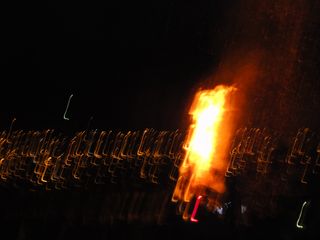
By Maniza Naqvi
Out of sync by six hours and seven years, this ancient country's, age old way of marking time. A half century completed, mine. I find, here years gained, time lost, at the end of the Meher rains, and the festival of Meskel—in the month of Meskerem. I am here. Fire and water on my mind: a burning, a drowning, a joy and a sorrow.
September 11, 2010 marked the new year of 2003, at exactly 6 .00 pm, in the month of Meskerem, Ethiopian time. I am— I think, finally, perhaps, at the exact and true time. I am here during Meskel-the celebration that commemorates the “Finding of the True Cross” by Queen Helena in the 4th century in Jerusalem. Having seen in a dream, the way that she would find the true cross, she ordered a bonfire to be sprinkled with Frankincense and lit— its smoke rising and falling to the spot where the true cross was buried. Each year the celebrants light bonfires and candles, dance, chant, pray and renew faith.
Here, confirmation and joy, is expressed almost as a sob, a sigh, or a breathless surprise. I am here in the season between exquisite joy and sorrow when rains much prayed for have come on time but have not left. The long rains this year are perhaps too long. Much before now and every year I have been drenched by these Meher rains from Ethiopia in a place elsewhere and faraway. Elsewhere bonfires of faith are under contemplation. Elsewhere floods threaten annihilation. Elsewhere a summer ends and winter begins. For they say in Pakistan, where the rains have stayed long this year and where the Indus is in flood this year, they say that the Monsoon, comes from here. The Meher in Ethiopia used to make a season of love elsewhere. I am here at the source of that season of love and rebirth, the Monsoon.
For they say in Pakistan, where the rains have stayed long this year and where the Indus is in flood this year, they say that the Monsoon, comes from here. The Meher in Ethiopia used to make a season of love elsewhere. I am here at the source of that season of love and rebirth, the Monsoon.
In the season of hide and seek between darkening rain and smoky light—in this place where identities blur, each candle lit from another, I too am here, where the faces of fruitsellers, priests, mullahs, professors, farmers, goat herders, bankers and the conductors hanging out of the blue van taxis calling out the next destination, resemble those east of here and west of here and of the icons revered in churches in St. Petersburg and Belegrade. And where the call from the church and the mosque carried on the breeze echo and sound the same. It is noon on Sunday–I listen to the singing that sounds like a dirge from the church that comes over the breeze in undulating waves to me. All its intonations familiar—the pathos of a Marsiya or a Noha or a Salaam during Moharam and the defiance of Qatubas of Friday prayers—or the rebuke of ghazals—that way of singing, that way of engagement, endearment, transports me to another place—all things known disappear and melt into a new familiar. I am taken aback, by seven years—set off kilter, by six hours, steadied back into balance, by what matters, in this place that marks its own time while the world marks another, hours forward by years back.
All of these sounds, the calls to prayers, seem the same to my ears and that perhaps is because the call for prayer began from here most probably, the same call to prayer brought to Islam by Bilal al Habashi. He is attributed for delivering the first call of prayers, I would venture that he called to prayer in the manner that he already knew how to do and so beautiful was it in its rendering that those who considered themselves superior to him in station took ownership of his initiative. There over the breeze as suddenly as it starts, it is gone, the azaan.
Rain just started has as suddenly moved on–The sun, blurred till now peaks out as though from inside its wrap of a soft white gauze just as bright yellow breasted birds alight on the balcony. Blue painted taxis, inch their way through traffic towards the hill where the palace sprawls and from there all the way down the slopes of the hillside shanty towns cascade downwards. Rumor has it that Haile Selassie’s ghost probably walks the corridors of the palace —and the only others in there behind those heavily guarded walls are prisoners and may as well be ghosts, held in the barracks in the ground below. An Emperor and his palace makes prisoners of men. And women. Still.
Again the call begins. This time, the churches. The sound that floats to me is distilled through my filters and transforms into the familiar sound of mourning. A lament, a catch in the voice, about the plight of kings, an intonation that the inheritance of true Kings, princes and princesses is poverty that truth can only be destitute—persecuted—exiled—dispossessed. Never to be rich, that is the mark of true kings, the lions of God, never to possess except the bounty of poverty. Such is the message that can only be contrived in a palace.
There is thunder, a storm is brewing and the calls of prayer are joined by the tap-tap, thud-thud sound of construction from the high rises going up all around are a clear indication that change is massively and rapidly afoot here. High rises are under construction all around—and on the outskirts of Addis, gated communities are going up of villas-with terracotta roofs and faux roman colonnades for the Diaspora to purchase.
Nearby a greenhouse and hot house plants —all waiting to be transferred to the hotel nearby for the pleasure of the guests there. Almost all of them here, I would wager in the name of poverty reduction. Inside my room, the storm, on television is on mute—for the story has run over and over again—of a possible burning of the Koran.
Could it be possible that all of religion—is about the rains? The burning anxiety for their arrival and fear of their staying too long. Followed by warmth and relief at their timely departure. Could religion be the eternal recording of the anxious searching of the night sky for the brightness of the stars and divining from the clarity of these criss-crossing points of lights shooting out in four, five or six directions the arrival and departure of the rains? The appeasing of the sun, the praising of the stars, the beseeching of the moon? Could the call to prayer, carried over through time be the beckoning of people to participate in a communal cajoling of the true mercurial tempered emperor, rain, to stay on schedule? To be merciful, to be kind? Could all religion be the anxiety wrought by the fear of what if, it is, too much, or too little, or too late? Could all of religion be a translation of this anxiety for survival, a desire to shed the shroud of despair with a persistence of hope? Could religion be a metaphor for the story of need and want for exactly that which can bring joy but once arrived in abundance wreaks havoc? Could religion and its accompanying props and paraphernalia all be in support of the retelling of this—ordinary story about rain—morphed into a story about a dangerous love, a narrative layered and coded beyond recognition of a justification of that individual universal fear of too little or too much and the communal instinct of survival through the rejection of a possibility that fear need not exist? And the eternal collective remorse that when things go wrong it is always because of something shameful, because of a fault—something left wanting and therefore the need for eternal penance and search for forgiveness? Could it be so, that holy is the making unholy of an abundance of love?
A tiny yellow bird, lands on the railing of the balcony and there it remains for a few moments in communion with me —a thought occurs, in this land of frankincense and myrrh–and Bilal Habasha——in this land of mosques and churches singing out the call to prayer, of Meskel, Eid and the Epiphany, of processions of taboots — in this the land of the Lion of God, the Queen of Sheeba and the traces of King Solomon, in this land of a Queen who seduced a King and who bore him a son—a thought occurs to me: Is it always about the seduction of a King by a queen and the bearing of a son? The attraction between “the others” and the inevitable seducing of the other, come to me—come to me—-to a union come—to an adoration.
I put my question to my tiny visitor. I am from here she says and you? And I reply—I am from somewhere near the Abyssinia lines—-and I tell her that monsoon comes there from here. I tell her the clouds go from here across the Indian Ocean reaching the shores over there making their way north past the desert, past the plains to the highlands there, then crashing into the wall of the Himalayas. And there stopped by that wall of mountains, stunned and crowded in that way, they have no other path but to stagger backwards, breakdown and weep and flood the plains. Bringing joy and bringing sorrow. She calls to me, you are here! You are from here. Just then, thunder rolls from the direction of the hills and startles her and with a swift flapping of her wings she is gone. This year the Meher has been plentiful and long. The Nile is in flood here. And there—in the land of my birth the Indus has over reacted and gone further and spilled into the plains and much lies in ruin. Such over abundance of benevolence is to be feared, kept in check with prayer. Could holy be the making unholy of the overflowing of love? Can only a fire or a flood, a burning or a drowning lead to rebirth?
(photographs from Meskel this year 2003 and 2010, September and Meskerem)
More Writing by Maniza Naqvi (here)
The more I read about the so-called enthusiasm gap among Democrats—the idea that they have so lost their enthusiasm for President Obama that they somehow won't be able to vote in next month's Congressional and local elections—the more I wonder about the lack of public skepticism about its existence. True, one hears a lot of bellyaching on the left these days, but when does one not hear bellyaching on the left? Come Election Day, the enthusiasm gap may turn out to be true, and it may not. Given the talent gap in the Republican Party and its surfeit of certifiable psychos, a.k.a. the Tea Party, there could just as likely be something stronger brewing among the center-right: a revulsion gap, i.e. Republican voters unable to vote for kooks like Rand Paul in Kentucky, Sharron Angle in Nevada, and Sarah Palin's uncanny double, Christine O'Donnell of Delaware.


 For they say in Pakistan, where the rains have stayed long this year and where the Indus is in flood this year, they say that the Monsoon, comes from here. The Meher in Ethiopia used to make a season of love elsewhere. I am here at the source of that season of love and rebirth, the Monsoon.
For they say in Pakistan, where the rains have stayed long this year and where the Indus is in flood this year, they say that the Monsoon, comes from here. The Meher in Ethiopia used to make a season of love elsewhere. I am here at the source of that season of love and rebirth, the Monsoon. This is the question anybody who reads your book is going to ask first: how many countries are you up to?
This is the question anybody who reads your book is going to ask first: how many countries are you up to?